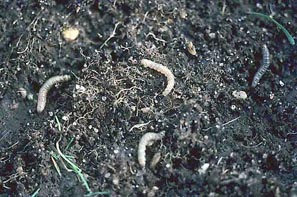Cranberry Girdler | |
|---|---|
| September 4, 2008 | |
|
Be watchful for cranberry girdler, a sod webworm that feeds on turf roots and causes damage like a white grub. The adult is similar in appearance to other sod webworm moths, being elongate and about 1/2 to 3/4 inch long, with elongated palps that look like a snout. The wings have more markings, with black spots and orangish coloration towards the end. Unlike other sod webworm moths that fly over turf areas, scattering their eggs, cranberry girdler moths drop theirs while sitting on grass blades from late June to mid-August. With each moth producing up to 500 eggs, locally high infestations can result. The eggs hatch into elongated whitish larvae, like sod webworms; but they have no spots. Larvae grow to be about 3/4 inch long. They feed on cool season grasses, including Kentucky bluegrass, bentgrass, and fine fescues, eating the stems, roots, and crowns. Damage appears similar to that of white grubs, with brown patches that can easily be pulled back to reveal the whitish caterpillars in the root zone. Whitish webbing containing fecal matter is also commonly present by late August into September. Larvae overwinter to resume feeding the following spring. They then pupate and emerge 2 to 4 weeks later as moths. Control cranberry girdler as you would white grubs, using either trichlorfon (Dylox), halofenozide (Mach 2), or clothianidin (Arena) watered into the soil. Imidacloprid (Merit) should not be used for this insect, as it is not effective against caterpillars. Pyrethroids, typically used to control sod webworms, tend to lose effectiveness in the soil and are not recommended for this pest. | |
| Author: | Phil Nixon |

